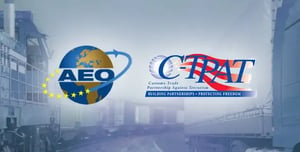The rise of nearshoring to Mexico presents a wealth of opportunities for companies looking to optimize their supply chains and tap into the North American market. However, concerns about security and border delays can sometimes be a hurdle. This is where Mexico’s Authorized Economic Operator (AEO) program plays a crucial role, enhancing nearshoring security and efficiency for businesses operating in the region.
Mexico’s AEO Program
Driven by the World Customs Organization and launched on January 2, 2012, the AEO program has been pivotal in fostering secure and efficient trade operations. The program enables participation from importers, exporters, customs brokers, warehouse keepers, and other stakeholders. It aims to boost fiscal, customs and security compliance by identifying internal and external risks. It applies administrative benefits to trade compliance operations.
Operating under the Customs Law, the AEO program has certified 1,055 operators to date, which represents more than 61% of National Foreign Traders. It has been implemented in 83 countries, and 7 others are in development. There are 108 Mutual Recognition Agreements signed among countries around the world, 103 bilateral and 5 plurilateral. In fact, Mexico has MRAs signed with 6 countries including: the United States, Canada, Corea, Costa Rica, Israel, and the Pacific Alliance.

AEO Certification
The Mexican Tax and Customs Authorities (SAT for its Spanish acronym) grant certification. It is part of essential treaties. Below are the general requirements for the AEO, summarizing 11 security standards and 42 sub-standards:
- Have held International Trade operations during the previous 2 years, accredit-able through a company that is part of the same group
- Company with the Security Standards (company security profile)
- If the company is part of the IMMEX Program, it must comply with specific requirements
AEO Certification Process
The certification process entails a comprehensive evaluation of applicants’ tax and customs compliance. This involves analyzing security profiles and conducting validation visits to facilities involved in foreign trade operations. After successful completion, the AEO authorization issues, which is valid for two years.Mexico’s AEO program success reflects the commitment of Mexican businesses to comply. They gain access to streamlined trade processes and improved competitiveness. If a company has already been certified by the USA Customs and Border Protection Program (CTPAT) Mexican Customs recognizes the certification by simplifying the certification process.

AEO Benefits
Participating in Mexico’s AEO program yields substantial benefits. It simplifies administrative processes, reduces customs inspections, provides priority in inspection lines, and grants access to exclusive lanes. Operators also benefit from extended timeframes for temporary import goods and increased flexibility for amendments and corrections after customs clearance. In total, the certification grants 30 fiscal and customs benefits when companies exports and/or imports to/from the United States. It gives additional advantages granted by the U.S. Customs authorities, even more if it is CTPAT-certified.
IVA/IEPS Certification Benefits
In July 2020, some VAT/IEPS Certification benefits were transferred to the AEO Certification. This included the possibility to perform virtual exports with non-IMMEX Mexican companies. Other benefits for AEO companies include:
- Minimum percentage of customs inspections and priority in case of inspection
- 36-month stay in temporary imports
- No declaration of serial numbers in the customs entry
- Access to preferential lanes in border crossing, such as FAST lanes
- No suspension of the importer registry prior to notification of the cause
- Dedicated AEO specialist at the SAT (Mexican fiscal authority)
- A recognized trademark worldwide, AEO exists in many countries
- Use of the AEO logo
- Origin inspection procedure (Article 98 LA)
- Rectifications without the need for authorization in fields that require it
- Facilities in handling excess goods during clearance
When a company is CTPAT-certified, it expedites its process through a joint inspection conducted by the U.S. Customs Border Patrol and the SAT. In fact, there are ongoing efforts to optimize the existing mutual recognition agreements (MRAs). Mexico’s Customs is currently working on a harmonization of its AEO program with CTPAT. It is also seeking to establish new ones, considering those countries where Mexican companies export.

Nearshoring in the USMCA
The United States-Mexico-Canada Agreement (USMCA) includes a chapter on facilitation that addresses various aspects of trade facilitation between the three member countries. Within this chapter, there is a specific article (Article 7.12) that focuses on Authorized Economic Operator (AEO) Programs.
The USMCA’s provisions on AEO programs reflect the commitment of the member countries to enhance trade facilitation and promote secure supply chains. The agreement recognizes the value of the AEO programs and encourages cooperation. Further, it seeks to streamline procedures as well as create a more efficient and secure trading environment.
In the world of nearshoring, security and efficiency and intertwined. Mexico’s AEO program addresses both these concerns, transmitting peace of mind and a significant competitive edge. By becoming AEO-certified, you demonstrate a commitment to secure practices. This fosters trust with customs authorities, thus streamlining your nearshoring journey.
Conclusion
Mexico’s AEO program is a valuable tool for companies looking to establish or expand their manufacturing presence in North America. With its focus on security and efficiency, the AEO program removes a layer of complexity from the nearshoring process. Now you can focus on what matters most: growing your business.
Prodensa can support companies seeking to certify themselves as Authorized Economic Operators in Mexico.
- Diagnosis – identify procedures; site visit and compliance validation; gap analysis with action plan
- Implementation – advisory for compliance procedures, formats, registries, policies, etc; co-develop and implement missing procedures
- Application – AEO filing; support during validation site visit; delivery of electronic files
- Maintenance – once certified, periodic compliance review and/or training
The SAT timeframe to the initial resolution is 120 days. You need to renew it every 2 years by presenting the renewal request once you obtain it.
Download the free Doing Business in Mexico e-book.
References = Article 100-A and 100-B of the Customs Law, supported by the General Rules for Foreign Trade, Title 7 and https://aeo.wcoomd.org/






